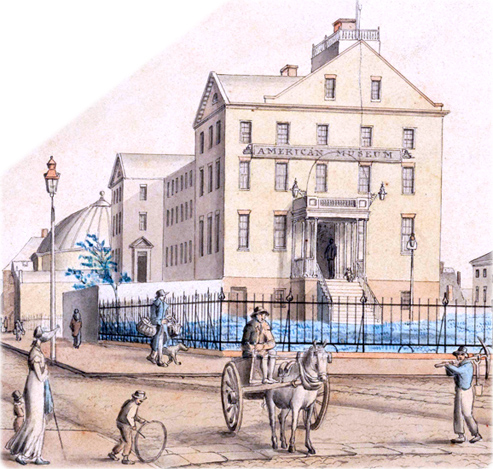
Scudder's American Museum
The Scudder's American Museum operated in New York City, from 1810 to 1841, in three different locations: 21 Chambers Street, in the old Alms House , in City Hall Park, and on Broadway, corner of Ann Street.
The origins of this American Museum go back to a museum established by the Tammany Society in June, 1790, for the purpose of collecting and preserving everything related to the history of America and American production of nature or art. The name "American Museum" was used in August, the same year, in a petition to the Common Council, stating that: having established an American Museum and having already received several donations, the museum was “destitute of a proper place for depositing the same.” The committee representing the Tammany Society asked for “one of the rooms in the City Hall of this City, for their temporary accommodation". On September 2, the board granted the society “the use of the upper room in the city hall in front of the Library Room whenever the same shall be cleared by the officers of Congress". In 1793, the "Tammany Museum" moved to the old Exchange, on the foot of Broad Street. In 1795, Gardiner Baker took over the museum. Baker died in 1798, and the museum was continued by Mrs. Baker. The Exchange building was demolished in 1799 and the museum moved to 222 Greenwich Street. In 1800, after the death Mrs. Baker, the museum collection was bought at auction by William I. Waldron. The "American Museum" was announced to reopen on July 4th at 226 Greenwich street. On September 15, Waldron offered the museum collection and building (two stories high, 42 feet front, 75 feet deep) for sale (Am. Cit.). Later, the collection came into the hands of the artist Edward Savage (1761–1817), who opened the Columbian Gallery of Painting and City Museum in 1802, and hired John Scudder to oversee the museum's collection.
In 1809, Scudder acquired the collection and opened the American Museum in March 1810 at 21 Chatham Street. In July 1817, it moved to the former Alms House building, in the City Hall Park (see above on the right). At the time the collection included 80 stuffed animals and over 160 glass cases, with 600 specimens. People in all parts of the country had sent in relics and rare curiosities. In 1820, Scudder’s American Museum was enlarged by consolidation with the Grand Museum.
Scudder died in August 1821. His son John Scudder, Jr. and his four daughters were too young to take over their father's position. The museum was managed by five trustees, led by attorney Cornelius Bogert, according to the Scudder's will. In 1826, the American Museum was renovated and presented new additions like the cosmorama, (later called stereographic views) which consisted of 47 optic glasses and of many distinct views of several cities and landscapes around the world. The first U.S. flag raised in New York City on Evacuation Day, 1783, with 13 stars, was also added to the collection.
In 1830, the American Museum lost its rent-free space at the old Alms House and built a five-story building, with marble façade, on the corner of Broadway and Ann Street, the same year. This new structure was announced in March that year. The museum reopened on the new premises on December 24, 1830, and it was announced as "the largest museum in America". The collection was enlarged and the cosmorama had then one hundred glasses. The trustees handed over the administration of the museum to the young John Scudder, Jr.
After five years the museum accumulated big debts and the museum's finances continued to falter until it was acquired in 1841 to P.T. Barnum, who renamed the museum as the Barnum's American Museum.
The Scudder's American Museum in 1825, in the old Alms House building, on the northern end of the City Hall Park, seen from Broadway and Chambers Street, looking east. The Rotunda is behind the Museum (fragment of a watercolor by A. J. Stansbury).
The Scudder's American Museum in 1831, its second site on Broadway, corner of Ann Street (click on the image for more information).
|
Copyright © Geographic Guide - Old NYC. Historic Buildings. |
Jonildo Bacelar, Geographic Guide editor, March 2025.
Scudder's American Museum
